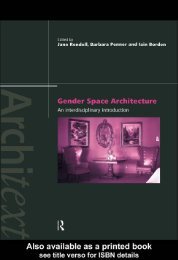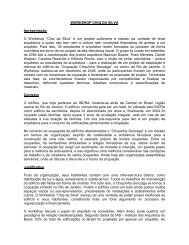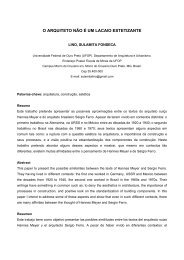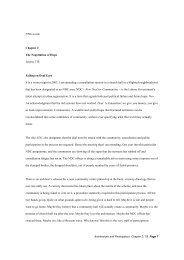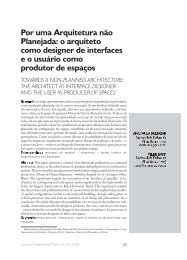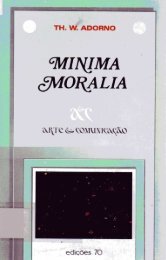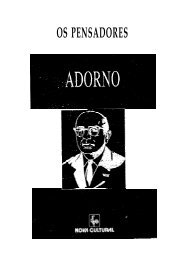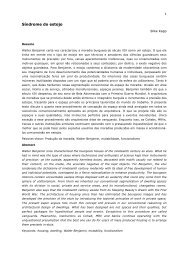Architecture and Modernity : A Critique
Architecture and Modernity : A Critique
Architecture and Modernity : A Critique
You also want an ePaper? Increase the reach of your titles
YUMPU automatically turns print PDFs into web optimized ePapers that Google loves.
ecause it is an authentic expression of the “poverty” that is typical of this civilization,<br />
thus foreshadowing the realization of a transparent <strong>and</strong> classless society. It is in<br />
his vision of architecture that we find the quintessence of his ambivalent attitude toward<br />
modernity. For a proper underst<strong>and</strong>ing of his ideas on this subject it is first necessary,<br />
however, to look at his linguistic philosophy that underlies both his theory of<br />
experience <strong>and</strong> his views on the theory of history.<br />
Mimesis <strong>and</strong> Experience<br />
Benjamin’s notions about language differ fundamentally from the ideas that are generally<br />
current in semiotics. 47 In his opinion language is not based solely on the<br />
conventional relationship between signifier <strong>and</strong> signified. In addition to this<br />
communicative dimension of language, which he calls “semiotic,” he distinguishes<br />
a second, “mimetic” dimension that he sees as the origin of language. This mimetic<br />
level of language is less easy to locate than the semiotic one. The best way of describing<br />
it is as an extrapolation of the onomatopoeic character of language: just as<br />
words such as “cuckoo” <strong>and</strong> “tick-tock” resemble the thing that they denote, from<br />
a broader perspective language as a whole can be seen as a sort of imitation (mimesis)<br />
of the world.<br />
Language as we know <strong>and</strong> use it, according to Benjamin, is a pale reflection of<br />
an original language that named things on the basis of similarities. The essence of<br />
this original language—<strong>and</strong> therefore of every language—is the name. This is the object<br />
of a mimesis, <strong>and</strong> is therefore linked by a relationship of similarity to the thing or<br />
person that bears this name. This mimetic structure, however, is no longer immediately<br />
recognizable <strong>and</strong> present in current language: it is no longer expressed in every<br />
individual word. Benjamin maintains nevertheless that, no matter how much it has<br />
been diluted <strong>and</strong> diminished, the mimetic structure continues to determine what language<br />
is. Not only can it be found between the spoken word <strong>and</strong> its meaning; it is<br />
also present between the written word <strong>and</strong> its meaning, <strong>and</strong> between the written<br />
word <strong>and</strong> the spoken. We become aware of this in the act of reading. Reading is<br />
more than just stringing together simple verbal meanings. In the act of reading a sort<br />
of abstract correspondence—Benjamin uses the term “unsinnliche Ähnlichkeit” 48 —<br />
can be observed in the similarity between text <strong>and</strong> reality that is “illuminated” at the<br />
moment one underst<strong>and</strong>s it. This nonsensuous similarity is embodied in the constellations<br />
that words form in combination with each other: just as the constellations<br />
of stars in the cosmos are interpreted by astrologers who can use them to make predictions,<br />
so words with their mutual relations <strong>and</strong> interplay create a correspondence<br />
with reality. Or, as Cyrille Offermans puts it:<br />
For Walter Benjamin, as for Adorno, a text is a sort of force-field: an exchange<br />
of semantic energy occurs in the words. A conscious use of language<br />
..... amounts to creating such a force-field....... The more<br />
3 Reflections in a Mirror



